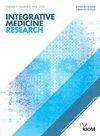药物穿刺与物理疗法治疗慢性腰痛的成本-效用分析:一项多中心、实用的随机对照试验
IF 3
4区 医学
Q2 INTEGRATIVE & COMPLEMENTARY MEDICINE
引用次数: 0
摘要
慢性腰痛(cLBP)是一个重要的全球健康问题,导致残疾和经济紧张。非药物治疗,如针灸和药物穿刺(PPT)等综合方法,已显示出减轻cLBP负担的潜力。本研究旨在从医疗保健系统和社会角度评估PPT与物理治疗(PT)相比治疗cLBP的成本效益。方法采用多中心、两组随机对照试验,纳入100例cLBP患者。患者被随机分为PPT组和PT组,在5周内接受10次治疗。使用EuroQol 5维5级量表(EQ-5D-5L)测量效用以计算质量调整生命年(QALYs),并从医疗保健和社会角度评估成本,包括医疗成本和生产力损失。使用工作效率和活动障碍(WPAI)问卷评估生产力损失。增量成本-效果比(ICERs)通过将成本差异除以两组间质量质量年的差异来计算。采用自举和敏感性分析来评估稳健性。结果sppt比PT更具成本效益,特别是从社会角度来看,它显示出更低的总成本和改善的质量。从医疗保健系统的角度来看,PPT的ICER为16,575美元/ QALY,表明成本效益。敏感性分析证实了这些发现的稳健性。结论本研究强调PPT是治疗cLBP的一种具有潜在成本效益的替代方法,但建议进一步研究更大的样本量和延长随访时间来验证这些结果。临床试验注册:clinicaltrials .gov (NCT04833309),临床研究信息服务(KCT0006088)。本文章由计算机程序翻译,如有差异,请以英文原文为准。
A cost-utility analysis of pharmacopuncture versus physiotherapy for chronic low back pain: A multicenter, pragmatic randomized controlled trial
Background
Chronic low back pain (cLBP) is a significant global health issue, contributing to disability and economic strain. Nonpharmacological treatments, such as acupuncture and integrative approaches like pharmacopuncture (PPT), have shown potential in alleviating the burden of cLBP. This study aimed to evaluate the cost-effectiveness of PPT compared to physical therapy (PT) for managing cLBP from both healthcare system and societal perspectives.
Methods
A multicenter, two-arm randomized controlled trial was conducted, involving 100 patients with cLBP. Patients were randomized into either the PPT group or the PT group, receiving 10 treatment sessions over five weeks. Utility was measured using the EuroQol 5-Dimension 5-Level scale (EQ-5D-5L) to calculate quality-adjusted life years (QALYs), and costs were evaluated from healthcare and societal perspectives, including medical costs and productivity loss. Productivity loss was assessed using the Work Productivity and Activity Impairment (WPAI) questionnaire. Incremental cost-effectiveness ratios (ICERs) were calculated by dividing the differences in costs by the differences in QALYs between the two groups. Bootstrapping and sensitivity analyses were performed to assess robustness.
Results
PPT was more cost-effective than PT, particularly from a societal perspective where it demonstrated lower overall costs and improved QALY. From a healthcare system perspective, the ICER of PPT was 16,575 USD per QALY, indicating cost-effectiveness. Sensitivity analyses confirmed the robustness of these findings.
Conclusion
This study highlights PPT as a potentially cost-effective alternative to conventional PT for cLBP, though further research with larger sample sizes and extended follow-up is recommended to validate these results.
Trial registration
ClinicalTrials.gov (NCT04833309), Clinical Research Information Service (KCT0006088).
求助全文
通过发布文献求助,成功后即可免费获取论文全文。
去求助
来源期刊

Integrative Medicine Research
Medicine-Complementary and Alternative Medicine
CiteScore
6.50
自引率
2.90%
发文量
65
审稿时长
12 weeks
期刊介绍:
Integrative Medicine Research (IMR) is a quarterly, peer-reviewed journal focused on scientific research for integrative medicine including traditional medicine (emphasis on acupuncture and herbal medicine), complementary and alternative medicine, and systems medicine. The journal includes papers on basic research, clinical research, methodology, theory, computational analysis and modelling, topical reviews, medical history, education and policy based on physiology, pathology, diagnosis and the systems approach in the field of integrative medicine.
 求助内容:
求助内容: 应助结果提醒方式:
应助结果提醒方式:


